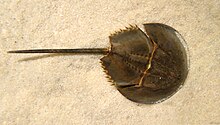圆尾鲎
| 圆尾鲎 | |
|---|---|

| |
| 科学分类 | |
| 界: | 动物界 Animalia |
| 门: | 节肢动物门 Arthropoda |
| 纲: | 肢口纲 Merostomata |
| 目: | 剑尾目 Xiphosura |
| 科: | 鲎科 Limulidae |
| 属: | 圆尾鲎属 Carcinoscorpius Pocock, 1902 |
| 种: | 圆尾鲎 C. rotundicauda
|
| 二名法 | |
| Carcinoscorpius rotundicauda (Latreille, 1802)
| |
| 异名 | |
|
Limulus rotundicauda Latreille, 1802 | |
圆尾鲎(学名:Carcinoscorpius rotundicauda),也叫马蹄蟹或鲎,是世界自然基金会“海洋十宝”之一,也是现存鲎类中个体最小的一种。圆尾鲎有毒[2]。
虽然被称为马蹄蟹,不过圆尾鲎实际上比起螃蟹,与蜘蛛和蝎子拥有更近的亲缘关系(同属于螯肢亚门)。圆尾鲎的名称缘由来自于其尾部(尾节)截面为圆形,其他种类的鲎尾部则皆为三角形[3]。
分布[编辑]

见于印度、孟加拉、印尼、马来西亚、新加坡、泰国、柬埔寨、缅甸、中国与香港沿海与汽水地区[4]。成年圆尾鲎多见于深水,而幼鲎多见于潮间带浅水区。
繁殖行为[编辑]
潮间带沙滩和泥滩是它们的繁殖地。圆尾鲎会于满月与新月水涨时到聚集至沙泥滩,圆尾鲎采单配偶制,雄鲎会透过螯肢攀附在雌鲎身上直到雌鲎产卵,每只雌性每次约产下二千枚卵,雄性会在雌性产卵后进行体外受精。但由于圆尾鲎在野外的存活率偏低,在一万只幼鲎中,大约只有1到2只可存活10到15年。
新加坡的圆尾鲎繁殖期为四月至八月,每次蜕皮后幼体的体型能增加33%,经历五次蜕皮后幼体就会从2厘米(0.79英寸)成长至成年体长[5]。
食物[编辑]
圆尾鲎为底栖生物,主要以沙虫、蠕虫、小蟹、蚝和贻贝的双壳类动物为食[6]。
与人类的关系[编辑]


圆尾鲎受到过度捕捞,数量已锐减[7]。但世界自然保护联盟红色名录把圆尾鲎列入“资料不足”部分。
圆尾鲎的肉并不多,但是其卵多半会被视为珍馐[8],圆尾鲎其实有毒性[9],与其他鲎不同,圆尾鲎含有足以使人类致命的河鲀毒素[10]。生物学上,其蓝色的血可用来缓解精神疲劳以及治疗肠胃炎。它们的血液还可以做成鲎试剂来进行内病原体脂多糖检测[7]。
参考文献[编辑]
- ^ Carcinoscorpius rotundicauda. The IUCN Red List of Threatened Species 1996. [April 18, 2010].
- ^ 晓石; 应红燕; 俞莹. 把它当中国鲎吃宁波6人差点丢性命·都市快报. hzdaily.hangzhou.com.cn (5638) (都市快报). 都市快报. 2014-06-16 [2017-03-20]. (原始内容存档于2018-08-06).为什么这么多人分不清圆尾鲎和中华鲎的区别? - 知乎 (页面存档备份,存于互联网档案馆)
- ^ About the Species. The Horseshoe Crab. [2018-06-26]. (原始内容存档于2007-02-12).
- ^ Stine Vestbo; Matthias Obst; Francisco J. Quevedo Fernandez; Itsara Intanai; Peter Funch. Present and Potential Future Distributions of Asian Horseshoe Crabs Determine Areas for Conservation. Frontiers in Marine Science. 2018, 5 (164): 1-16. doi:10.3389/fmars.2018.00164.
- ^ Lesley Cartwright-Taylor; Julian Lee & Chia Chi Hsu. Population structure and breeding pattern of the mangrove horseshoe crab Carcinoscorpius rotundicauda in Singapore. Aquatic Biology. 2009, 8: 61–69 [2018-07-21]. doi:10.3354/ab00206. (原始内容存档于2020-11-11).
- ^ H. Zhou & Brian Morton. The diets of juvenile horseshoe crabs, Tachypleus tridentatus and Carcinoscorpius rotundicauda (Xiphosura), from nursery beaches proposed for conservation in Hong Kong. Journal of Natural History. 2004, 38 (15): 1915–1925. doi:10.1080/0022293031000155377.
- ^ 7.0 7.1 Bibhuti Pati. Horseshoe crabs galloping towards extinction. Merinews. 2008-06-24 [2011-06-01]. (原始内容存档于2012-10-05).
- ^ 存档副本. [2018-07-21]. (原始内容存档于2020-10-30).
- ^ Ngy L, Yu CF, Takatani T, Arakawa O. Toxicity assessment for the horseshoe crab Carcinoscorpius rotundicauda collected from Cambodia. Toxicon. May 2007, 49 (6): 843–7. PMID 17261323. doi:10.1016/j.toxicon.2006.12.004.
- ^ Kanchanapongkul, J.; Krittayapoositpot, P. An epidemic of tetrodotoxin poisoning following ingestion of the horseshoe crab Carcinoscorpius rotundicauda. The Southeast Asian Journal of Tropical Medicine and Public Health. June 1995, 26 (2): 364–367. ISSN 0125-1562. PMID 8629077.
外部连接[编辑]
 维基共享资源上的相关多媒体资源:Carcinoscorpius rotundicauda
维基共享资源上的相关多媒体资源:Carcinoscorpius rotundicauda
|
